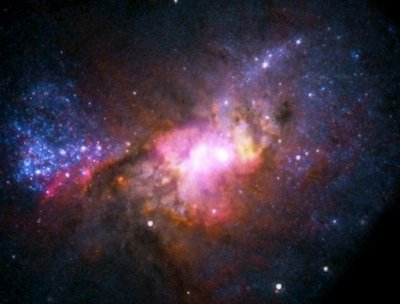
SYDNEY (AFP) – A 22-year-old Australian university student has solved a problem which has puzzled astrophysicists for decades, discovering part of the so-called "missing mass" of the universe during her summer break.
Undergraduate Amelia Fraser-McKelvie made the breakthrough during a holiday internship with a team at Monash University's School of Physics, locating the mystery material within vast structures called "filaments of galaxies".
Monash astrophysicist Dr Kevin Pimbblet explained that scientists had previously detected matter that was present in the early history of the universe but that could not now be located.
"There is missing mass, ordinary mass not dark mass ... It's missing to the present day," Pimbblet told AFP.
"We don't know where it went. Now we do know where it went because that's what Amelia found."
Fraser-McKelvie, an aerospace engineering and science student, was able to confirm after a targeted X-ray search for the mystery mass that it had moved to the "filaments of galaxies", which stretch across enormous expanses of space.
Pimbblet's earlier work had suggested the filaments as a possible location for the "missing" matter, thought to be low in density but high in temperature.
Pimbblet said astrophysicists had known about the "missing" mass for the past two decades, but the technology needed to pinpoint its location had only become available in recent years.
He said the discovery could drive the construction of new telescopes designed to specifically study the mass.
Pimbblet admitted the discovery was primarily academic, but he said previous physics research had led to the development of diverse other technologies.
"Whenever I speak to people who have influence, politicians and so on, they sometimes ask me 'Why should I invest in physics pure research?'. And I sometimes say to them: 'Do you use a mobile phone? Some of that technology came about by black hole research'.
"The pure research has knock-on effects to the whole society which are sometimes difficult to anticipate."
<한글 기사>
20대 여대생, 우주 수수께끼 '미싱 매스' 발견
이론상으로는 분명히 존재하지만 실제로는 관측 된 적이 없었던 '미싱 매스(missing mass)'의 실체가 20대 호주 대학생에 의해 처음 으로 확인됐다.
27일(현지시각) 호주의 언론 매체인 시드니 모닝 해럴드(SMH)는 현지 모나쉬 대학교에 재학 중인 아멜리아 프레이저-맥켈비(22)양이 학교에서 진행하는 여름 인턴십에 참가했다가 엑스레이 촬영을 통해 미싱 매스의 실체를 확인했다고 보도했다.
'보이지 않는 물질'이라고도 불리는 미싱 매스는 지난 수 십년 동안 천체 물리학계에서 풀리지 않는 수수께끼 가운데 하나였다.
미싱 매스는 은하단의 질량 측정과 연관된 개념이다. 지난 1933년 스위스의 물리학자인 프리츠 츠비키는 '코마'라는 거대 은하단을 관측하던 중 은하단이 유지되려면 보이지 않는 물질의 중력이 더 필요하다는 사실을 발견했다.
은하단 중심을 공전하는 은하들의 속도가 매우 빨라 실제로 관측되는 은하단 질 량의 중력만으로는 운동이 유지될 수 없다는 것. 결국 츠비키는 은하들이 튕겨나가지 않고 운동할 수 있는 것은 관측되지는 않지만 분명히 존재하는 보이지 않는 어떤 물질, 즉 미싱 매스의 중력 덕분이라는 이론상의 결론을 얻었다.
그러나 미싱 매스가 실제로 관측된 것은 이번이 처음이다. 이 물질이 은하계의 성단 사이에 확장돼 있는 필라멘트에 존재할 것이라는 그동안의 예측은 프레이저-맥켈비양의 발견을 통해 증명됐다.
모나쉬대 소속 케빈 핌블렛 박사는 프레이저-맥켈비양의 발견으로 미싱 매스에 대한 기존의 의문이 풀렸다고 말했다.
그는 미싱 매스의 양이 눈으로 관측되는 은하의 양보다 2배가량 많고, 대부분이 두꺼운 신발끈 모양의 필라멘트에 위치하며, 밀도는 낮지만 고온(섭씨 100만도)의 성질을 지녔다고 설명했다.
핌블렛 박사는 그동안 과학자들이 막연하게 추측했던 미싱 매스의 이런 성질들이 프레이저-맥켈비양의 발견을 통해 진실인 것으로 확인됐다며 의미를 부여했다.
(연합뉴스)




![[Herald Interview] 'Amid aging population, Korea to invite more young professionals from overseas'](http://res.heraldm.com/phpwas/restmb_idxmake.php?idx=644&simg=/content/image/2024/04/24/20240424050844_0.jpg&u=20240424200058)











![[KH Explains] Korean shipbuilding stocks rally: Real growth or bubble?](http://res.heraldm.com/phpwas/restmb_idxmake.php?idx=652&simg=/content/image/2024/04/25/20240425050656_0.jpg&u=)

